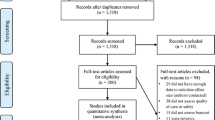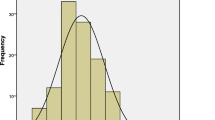Abstract
In the wake of uncertainty due to the H1N1 influenza pandemic, amount and sources of H1N1-related information were examined in a cohort at high-risk for respiratory complications. Factors associated with adequate amount of information were identified. A cross-sectional mailed survey was conducted in 2010 with veterans with spinal cord injuries and disorders. Bivariate comparisons assessed adequate H1N1-realted information versus not enough and too much. Multivariate regression identified variables associated with receipt of adequate information. A greater proportion who received adequate versus not enough information received H1N1 vaccination (61.87 vs. 48.49 %, p < 0.0001). A greater proportion who received adequate versus too much information received seasonal vaccination (84.90 vs. 71.02 %, p < 0.0001) and H1N1 vaccination (61.87 vs. 42.45 %, p < 0.0001). Variables associated with greater odds of receiving adequate information included being white, a college graduate, and having VA health professionals as their primary information source. Receiving adequate information was associated with lower odds of staying home with flu/flu-like symptoms, and higher odds of H1N1 vaccine receipt and wearing a facemask. Receiving appropriate amounts of information from valid sources may impact adherence to infection control recommendations during pandemics. Findings can be used to facilitate efforts ensuring information is received by high-risk populations.
Similar content being viewed by others
References
Brien, S., Kwong, J. C., & Buckeridge, D. L. (2010). The determinants of 2009 pandemic A/H1N1 influenza vaccination: A systematic review. Vaccine, 30(7), 1255–1264.
Bults, M., Beaujean, D. J. M. A., de Zwart, O., Kok, G., van Empelen, P., van Steenbergen, J. E., Richardus, J. H., & Voeten, H. A. (2011). Perceived risk, anxiety, and behavioural responses of the general public during the early phase of the Influenza A (H1N1) pandemic in the Netherlands: Results of three consecutive online surveys. BMC Public Health, 11(1), 2. Retrieved from: http://www.ncbi.nlm.nih.gov/pmc/articles/PMC3091536/?tool=pubmed.
Caress, A. L., Duxbury, P., Woodcock, A., Luker, K. A., Ward, D., Campbell, M., & Austin, L. (2010). Exploring the needs, concerns and behaviours of people with existing respiratory conditions in relation to the H1N1 ‘swine influenza’ pandemic: A multicentre survey and qualitative study. Health Technology Assessment, 14(34), 1–108.
Chan, M. (2009). World now at the start of 2009 influenza pandemic. [Statement to the press]. Retrieved from: http://who.int/mediacentre/news/statements/2009/h1n1_pandemic_phase6_20090611/en/index.htht.
De Zwart, O., Veldhuijzen, I. K., Richardus, J. H., & Brug, J. (2010). Monitoring of risk perception and correlates of precautionary behavior related to human avian influenza during 2006–2007 in the Netherlands: Results of seven consecutive surveys. BMC Infectious Diseases, 10, 114. Retrieved from: http://www.ncbi.nlm.nih.gov/pmc/articles/PMC2885389/?tool=pubmed.
Galarce, E. M., Minsky, S., & Viswanath, V. (2011). Socioeconomic status, demographics, beliefs and A(H1N1) vaccine uptake in the United States. Vaccine, 29(32), 5284–5289.
Horney, J. A., Moore, Z., Davis, M., & MacDonald, P. D. M. (2011). Intent to receive pandemic influenza A (H1N1) vaccine, compliance with social distancing and sources of information in NC, 2009. PLoS One, 5(6), e11226. Retrieved from: http://www.ncbi.nlm.nih.gov/pmc/articles/PMC2887902/?tool=pubmed.
Jehn, M., Kim, Y., Bradley, B., & Lant, T. (2011). Community knowledge, risk perception, and preparedness for the 2009 influenza A/H1N1 pandemic. Journal of Public Health Management and Practice, 17(5), 431–438.
Jetha, A., Faulkner, G., Gorczynski, P., Arbour-Nicitopoulos, K., & Martin Ginis, K. A. (2011). Physical activity and individuals with spinal cord injury: Accuracy and quality of information on the internet. Disability and Health Journal, 4(2), 112–120.
Kelley, M. M., Tharian, B., & Shoaf, K. I. (2011). Delivering health messages using traditional and new media: Communicating preferences of California residents during the 2009 H1N1 influenza outbreak. Proceedings from the 8th international association for information systems for crisis response and management [ISCRAM] Conference. Lisbon, Portugal. Retrieved from: http://www.iscramlive.org/ISCRAM2011/proceedings/papers/169.pdf.
Maurer, J., Uscher-Pines, L., & Harris, K. M. (2010). Perceived seriousness of seasonal and A(H1N1) influenzas, attitudes toward vaccination, and vaccine uptake among U.S. adults: Does the source of information matter? Preventive Medicine, 51(2), 185–187.
McInnes, D. K., Gifford, A. L., Kazis, L. E., & Wagner, T. H. (2010). Disparities in health- related internet use by US veterans: Results from a national survey. Informatics in Primary Care, 18(1), 59–68.
Merchant, R. M., Elmer, S., & Lurie, N. (2011). Integrating social media into emergency-preparedness efforts. The New England Journal of Medicine, 365(4), 289–291.
Pandey, A., Patni, N., Singh, M., Sood, A., & Singh, G. (2010). YouTube as a source of information on the H1N1 influenza pandemic. American Journal of Preventive Medicine, 38(3), e1–e3.
Pew Internet and American Life Project. (2007). E-Patients with a disability or chronic disease. Washington, DC: Fox, S. Retrieved from: http://www.pewinternet.org/~/media//Files/Reports/2007/EPatients_Chronic_Conditions_2007.pdf.pdf.
Redmond, N., Baer, H., Clark, C. R., Lipsitz, S., & Hicks, L. S. (2010). Sources of health information related to preventive health behaviors in a national study. American Journal of Preventive Medicine, 38(6), 620–627.
Roblin, D. W., Houston, T. K., Allison, J. J., Joski, P. J., & Becker, E. R. (2009). Disparities in use of a personal health record in a managed care organization. Journal of the American Medical Informatics Association, 16(5), 683–689.
Seale, H., Heywood, A. E., McLaws, M. L., Ward, K. F., Lowbridge, C. P., Van, D., & MacIntyre, C. R. (2010). Why do I need it? I am not at risk! Public perceptions towards the pandemic (H1N1) 2009 vaccine. BMC Infectious Diseases, 10, 99. Retrieved from: http://www.ncbi.nlm.nih.gov/pmc/articles/PMC2864274/?tool=pubmed.
van der Weerd, W., Timmermans, D. R. M., Beaujean, D. J. M. A., Oudhoff, J., & van Steenbergen J. E. (2011). Monitoring the level of government trust, risk perception and intention of the general public to adopt protective measures during the influenza A (H1N1) pandemic in the Netherlands. BMC Public Health, 11, 575. Retrieved from: http://www.biomedcentral.com/1471-2458/11/575.
Wong, L. P., & Sam, I. C. (2010). Public sources of information and information needs for pandemic influenza (H1N1). Journal of Community Health, 35(6), 676–682.
Acknowledgments
This material is based on work supported by the Office of Research and Development, Health Services Research and Development, and Spinal Cord Injury Quality Enhancement Research Initiative, of the Department of Veterans Affairs. This paper reflects only the authors' opinions, and does not necessarily reflect the official position of the Department of Veterans Affairs.
Conflict of interest
None of the authors have a financial or other relationship that might signify a conflict of interest.
Author information
Authors and Affiliations
Corresponding author
Rights and permissions
About this article
Cite this article
Etingen, B., LaVela, S.L., Miskevics, S. et al. Health Information During the H1N1 Influenza Pandemic: Did the Amount Received Influence Infection Prevention Behaviors?. J Community Health 38, 443–450 (2013). https://doi.org/10.1007/s10900-012-9647-8
Published:
Issue Date:
DOI: https://doi.org/10.1007/s10900-012-9647-8




